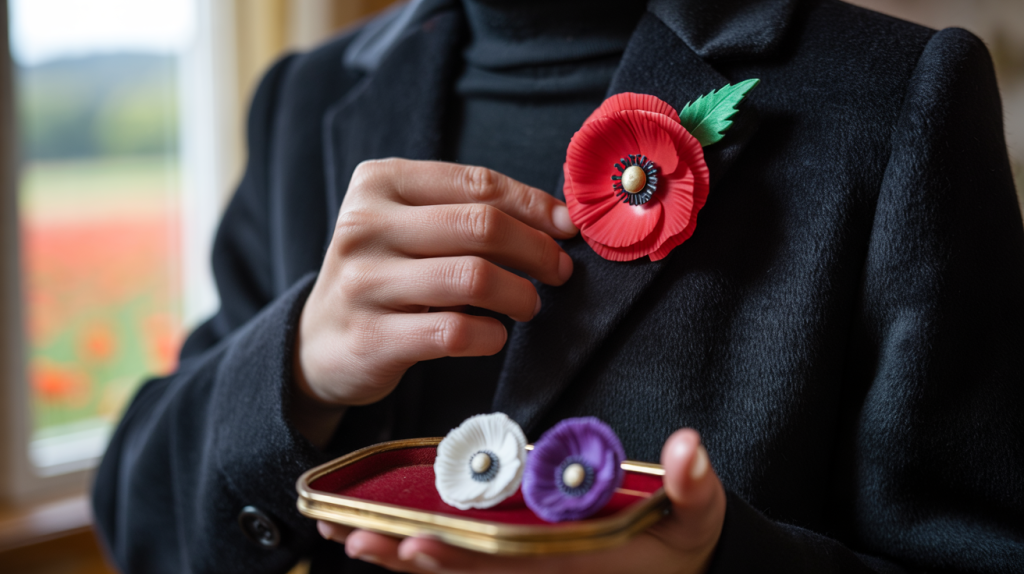Spot a small red flower on a lapel and a whole century of memory appears. The poppy pin signals remembrance for lives lost in war, support for veterans, and a quiet promise not to forget.
Its message is simple and powerful. Rooted in the First World War and a poem that changed how grief looks in public, the poppy has become a symbol worn across the United Kingdom, Canada, Australia, New Zealand, and beyond on and around 11 November. It is also a living symbol, with new colors and causes that add nuance without erasing the original meaning.
Poppy pin meaning today: remembrance and support
The red poppy pin says remembrance first. People wear it to honor those who died in service and to show respect to veterans and their families. It also signals a contribution to charities that provide housing, mental health support, and practical help to those affected by conflict.
That public act matters. It creates visibility for service and sacrifice, and it turns a private feeling into a shared moment. On 11 November at 11 o’clock, many observe two minutes of silence, a simple ritual that frames the poppy’s purpose.
From John McCrae to the Royal British Legion: a brief history
The origins trace back to a battlefield poem. In May 1915, Canadian physician John McCrae wrote “In Flanders Fields”, noting red poppies growing on freshly turned graves (source: Canadian War Museum). The flower became a sign of remembrance in the English speaking world.
The American Legion adopted the poppy as its memorial flower in 1920 (source: American Legion). In 1921, the Royal British Legion launched its first Poppy Appeal, using handmade poppies to raise funds for veterans and families after the war (source: Royal British Legion).
The symbol has inspired large scale tributes. In 2014, “Blood Swept Lands and Seas of Red” filled the Tower of London moat with 888,246 ceramic poppies, one for every British and Colonial military fatality in the First World War, drawing millions of visitors (source: Historic Royal Palaces).
How to wear a remembrance poppy pin: colors and etiquette
Traditionally, the red poppy appears from late October through Remembrance Sunday and Armistice Day. Many pin it on the left lapel near the heart, others on bags or coats. The Royal British Legion has stated there is no single correct way to wear a poppy, only the intent behind it (source: Royal British Legion).
Over time, colors have broadened the conversation. Red remains the historic symbol of remembrance. White highlights remembrance with an emphasis on peace and the commitment to reduce harm. Purple, used by some groups, commemorates animals that served and died in conflict.
- Red poppy: remembrance of the fallen and support for veterans charities
- White poppy: remembrance with a focus on peace and nonviolence, introduced in 1933 by the Cooperative Women’s Guild (source: Peace Pledge Union)
- Purple poppy: remembrance of animals in war, used by animal welfare groups
Small note on etiquette. Some believe the leaf should point at eleven o’clock, yet the Royal British Legion has repeatedly said personal choice guides how and where to wear it. That clarity reduces pressure, especially for those who want to honor but worry about getting it wrong.
Choosing your poppy pin: materials, sustainability, and where funds go
Poppies exist in paper, fabric, enamel, and ceramic. Paper poppies remain affordable and widely available through street collections and official sellers. Fabric and enamel versions last longer and can be worn year after year, including subtle lapel pins that suit formal outfits.
Many organizations now explore more sustainable designs, with plastic free stems or recyclable materials, to make remembrance kinder to the planet while keeping the symbol intact. This shift has moved faster since the mid twenty tens as charities listened to supporters and adapted.
Buying from official sources ensures proceeds fund specific support. The Royal British Legion Poppy Appeal finances welfare services, bereavement support, and community outreach for the Armed Forces community in the United Kingdom (source: Royal British Legion). In Canada, donations to the Poppy Fund stay in local branches to help veterans and families with urgent needs, from food to housing to mobility support (source: Royal Canadian Legion). The American Legion and American Legion Auxiliary run National Poppy Day events that raise funds for veteran assistance programs in the United States (source: American Legion).
One last practical tip. Choose the poppy that matches your intent, then wear it where it will be seen. A red paper poppy for public remembrance, a discreet enamel pin for work, a white poppy if peace is the theme of your message, or a purple one if you wish to mark the role of animals. The gesture is small. The signal is clear. And many who served will recieve it as a sign of care.
